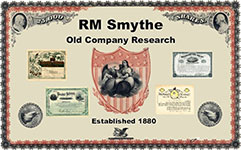Beautiful Old First Virginia Infantry 1861-1865 Ornate Document certifying that Captain Francis J. Boggs is a member of the old First Virginia Infantry and served honorably as a Captain in Co. H from the 21st day of April, 1861 to the 28th day of April, 1862. Signed "Wm. H. Palmer" (Major William H. Palmer ) and "Charles T. Loehr" beside a color imprint of the C.S. battle flag. Note on bottom written by Francis Bogg's Daughter. 
Certificate Vignette 
Signatures and Confederate Flag "Old First Virginia Infantry 1861-65" Ornate Document. This document was designed to be framed showing the Virginia state seal, battles engaged in (22) and certifying that William H. Stewart is a member of the old First Virginia Infantry and served honorably as a private in Co. D from the 21st day of April 1861 to the 26th day of August, 1862. Signed "Wm. H. Palmer" and "Charles T. Loehr" beside a color imprint of the C.S. battle flag. The First Regiment of Virginia Volunteers was created on May 1, 1851, from volunteer militia companies of the City of Richmond and its neighboring counties of Chesterfield and Henrico. The regiment held its first formation on May 29, 1851, in Broad Street before the City Hall, and from there marched to a nearby field, where, the Whig reported, its members "exhibited a commendable proficiency in the knowledge of military art.....and went through the various evolutions with ease and precision." The oldest of the companies was the Richmond Light Infantry Blues, which formed in 1793. Next in age were the cavalry and artillery companies: the Richmond Light Dragoons, which had a lineage going back to 1800; and the Richmond Fayette Artillery, organized as the Richmond Light Artillery in 1821, and renamed in 1829 to honor the Marquis de Lafayette, who visited Virginia that year. Also in the ranks of the First Virginia were the Richmond Grays, organized in 1844; the Montgomery Guard organized in 1849 from the Irish element of the city; the Eagle Infantry, organized in 1850; the German Rifles, organized in 1850 from Richmond's German inhabitants; the Young Guard, organized in 1850; and the Caledonian Guard, organized in 1850, and composed largely of Scots. The composition of the First Regiment underwent considerable change from 1851 to 1861. Some of the companies were short-lived, and were disbanded because of a lack of interest, which failed to keep them up to the strength required by law. The first lettered designation for the companies appeared in 1856, when the regiment was organized as follows: Co. A, Richmond Grays; Co. B, Young Guard, which, in 1857, was detached from the regiment, and assigned to the 179th Regiment (City of Richmond) of militia; Co. C, Montgomery Guard; Co. D, Eagle Infantry, disbanded in November l856; Co. E, Richmond Light Infantry Blues; Co. F, Richmond Fayette Artillery; Co. G, Continental Guard, disbanded in 1857; Co. H, Mechanic's Guard, disbanded in 1857; Co. I, National Guard; and Co. K, Virginia Rifles, formerly known as the German Rifles. On July 5, 1858, with other local, and visiting, militia commands, the First Regiment turned out to honor the reception of former President James Monroe's remains for burial in Hollywood Cemetery. A recent addition to the First was Co. D, Rocky Ridge Rifles, from Manchester, in Chesterfield County. It was about this time a regimental dress for the First was proposed, but the subject was temporarily dropped, as the companies were reluctant to giving up their favorite uniforms of gray, green, and blue. Eventually, a regimental dress was agreed upon, and, but slowly, the companies adopted it. The field and staff officers appeared in gray uniforms for the first time at the parade on February 22, 1860, and on April 10, 1860, all but one of the eight companies on parade turned out in gray. Even the Blues, in early 1861, adopted the gray regimental dress. On April 19, 1860, the First Regiment assembled, with eight companies, totaling 439 men, for the dedication of the Henry Clay statue on Capitol Square. Two companies, the revived Fayette Artillery, and Captain Randolph's Howitzers did not parade as they were insufficiently uniformed and equipped. Subsequently several new companies were raised and added to the regiment, and by April 1, 1861, the First, besides its band and drum corps, had eleven companies: Co. A, Richmond Grays; Co. B, Richmond City Guard; Co. C, Montgomery Guard; Co. D, Old Dominion Guard; Co. E, Richmond Light Infantry Blues; Co. F, Captain Cary's "F Company"; Co. G; Captain William H. Gordon's company; Co. H, Howitzer company; Co. I, Captain Robert Morris' company; Co. K, Virginia Rifles; and the Richmond Fayette Artillery, which, at this time, had no lettered designation. On April 19, 1861, Company A, Richmond Grays, enrolled for active service, and on the 21st, left for Norfolk, where, after August 1861, they were assigned to the 12th Regiment of Virginia Volunteers. The Fayette Artillery, which enrolled for active service on April 25, was detached from the regiment, and in May, was stationed at the Richmond College artillery barracks. Captain Randolph's Howitzers, Company H, went into quarters at the Spotswood Hotel on April 19, but later moved to Richmond College, where they were detached from the regiment, and reorganized into an artillery battalion. On April 21, Company E, the Richmond Light Infantry Blues, and Captain Cary's Company F, left Richmond for Fredericksburg, and were never returned to the regiment. The First Regiment assembled on April 27, and marched to Camp Lee at the Fair Grounds on the western edge of Richmond. On April 29, the Old Dominion Guard was mustered into service as Co. D. About May 4, Captain Francis J. Boggs' second company of Richmond Grays was assigned to the regiment, replacing the Howitzers as Company H. The long-expected day arrived on May 25, when the regiment boarded the train to join the forces being assembled at Camp Pickens, Manassas Junction. The First Regiment fought with distinction in many battles from 1861-65. Those battles included, Blackburn's Ford, July 18, 1861; 1st Manassas, July 21, 1861; Williamsburg, May 5, 1862; Seven Pines, May 31, 1862; Frayser's Farm, June 30, 1862, 2nd Manassas, August 30, 1862, Boonsborough, August 14, 1862; Gettysburg July 3, 1863; Plymouth, NC, April 17-20, 1864; Drewry's Bluff, May 16, 1864; Howlett House, May 18, 1864; Clay Farm, June 16, 1864; Dinwiddie Court House and Five Forks, March 31- April 1, 1865; Saylor's Creek, April 6, 1865, and Appomattox Court House, April 9, 1865. The First Regiment was reconstituted on October 25, 1871, and has since undergone many changes, especially during recent years. Upon the outbreak of the Spanish-American War, four companies were withdrawn from the First Regiment, and assigned to the Second and Third regiment of Virginia volunteers. In October 1900, the First Regiment war reorganized as the 70th Regiment, which, on September 1, 1908, was designated as the First Infantry Regiment, Virginia Volunteers. The First Regiment was called into service in 1916 for the Mexican Border, and in 1917, it again went into Federal service, and was consolidated with other Virginia regiments; to form the 116th Regiment, 29th Division. The First Regiment was reorganized in 1919, and in 1920, it bore the designation First Infantry Regiment, Virginia National Guard. In March 1922, it was redesignated as the 183rd Infantry Regiment, but in 1929, the regiment became the First Virginia Infantry Regiment. In 1941, when it again went into Federal service, the regiment was known as the 176th Infantry Regiment. Organized after World War II as an element of the 176th Regimental Combat Team, Virginia Army National Guard, the 176th Infantry (First Virginia), which included the battalions of Richmond Grays and Richmond Light Infantry Blues, was in 1961, reorganized into the 1st Battle Group, 176th Infantry. The Grays remained, but the Blues, which had been in and out of the regiment a number of times since 1871, were pulled out, and redesignated as the1st Reconnaissance Squadron, 183rd Armor, Va.ARNG. Another major change came on March 23, 1963, when the 1st Battle Group, 176th Infantry, was converted into the 276th Engineer Battalion (Combat), and attached to the 176th Engineer Group (Combat). Modified text from the Introduction by Lee A, Wallace, Jr. from Charles T. Loehr's War History of the Old First Virginia Infantry

Certificate Vignette

Signatures and Confederate Flag













